Cooler Master MWE Gold 750 V2 Power Supply Review
Mike Sanders / 4 years ago
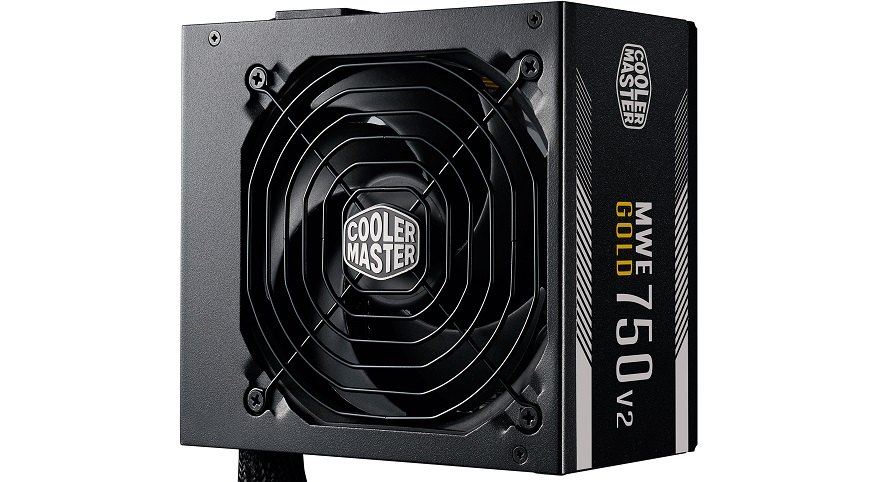
Cooler Master is undoubtedly one of the most recognizable brands around when it comes to PC hardware and peripherals. As such, when it comes to purchasing a product from one of their various lines (and trust us, there’s very little they don’t make), you can do so in full confidence that you’ll be getting a quality design from one of the most reputable names around.
With the launch of the new Cooler Master MWE Gold 750 V2 power supply, therefore, you should already have a pretty decent idea that this PSU is going to be packed full of excellent features.
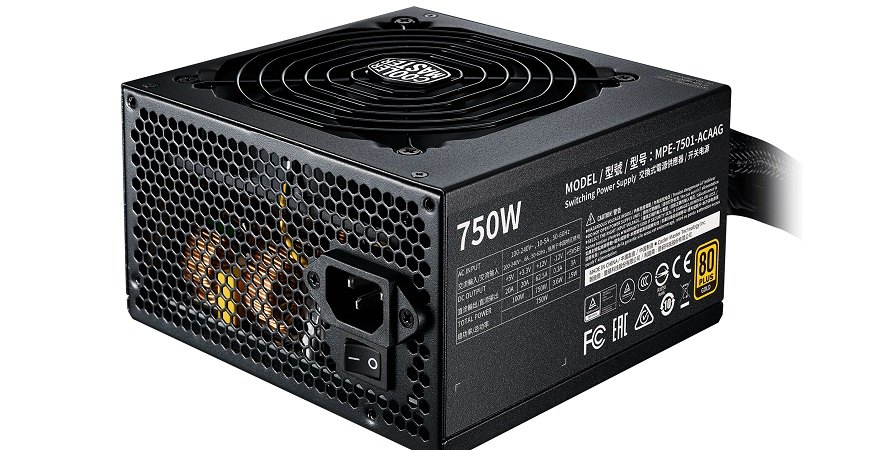
Cooler Master MWE Gold 750 V2
The Cooler Master MWE Gold V2 range is available in wattages from 550w all the way up to 850w. For this review, however, we will be taking a closer look at its 80-plus Gold 750w model. A solid option that, generally speaking, should provide the perfect power access point for the vast majority of gaming PCs.
Released as a new V2 variant, Cooler Master has applied a number of small, but notable, upgrades on the original design that should, all going well, translate into this being even more impressive.

What Does Cooler Master Have to Say?
“The MWE Gold – V2 is the next step in the evolution of Cooler Master’s entry level 80 PLUS Gold power supply unit line. The original MWE Gold series was created in order to offer a simpler and more affordable Gold rated option in order to help users make the transition from 80 PLUS White and Bronze power supply units more accessible. While there is still demand for White and Bronze units, the global standard has been shifting to Gold. Some countries have even begun to legislate 80 PLUS Gold efficiency as the legal minimum to purchase. This is why bringing affordable options like the MWE Gold is so important to Cooler Master. The MWE Gold – V2 improves upon the original version in the places where users will see the most immediate benefit.”

Features
- 80 Plus Gold Efficiency
- 2 EPS Connectors
- 120mm HDB Fan
- High Temperature Resilience
- Flat Black Cables
- 5 Year Warranty

Specifications
For more details specifications, please visit the official product page via the link here!

Connections
Coming as a fully-modular design, the Cooler Master MWE Gold 750 V2 comes with more than enough cables to successfully hook up even some of the most elaborate gaming PCs. Better still, with a nice and generous cable length, management within your case should be an absolute doddle!


Packaging
The box work for the Cooler Master MWE Gold 750 V2 is certainly more than a little eye-catching with it’s black/silver with purple highlight coloring. Starting with the front, however, you are given a nice clear view of the power supply as well as all of its key features being clearly displayed.
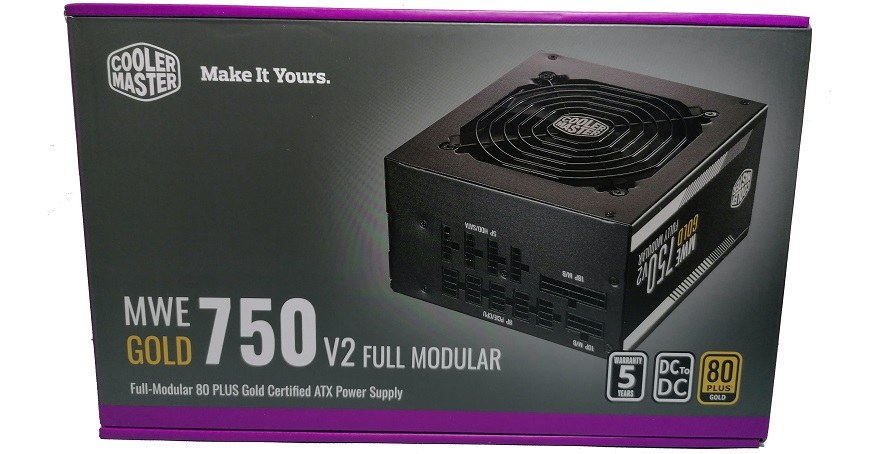
The rear goes more into more of the technical specifications and features and, in terms of the information presented, provides you with absolutely everything you could want to know. Overall, in terms of the detail and style, Cooler Master has really hit the nail on the head here!
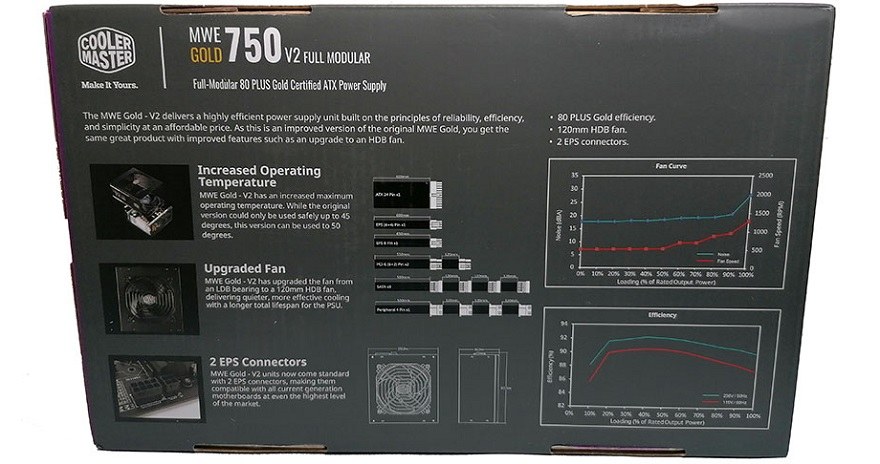
Accessories
In terms of accessories, you don’t really get much from out of the box except a product manual (that’s a little bit unimpressive to look at) as well as the screws necessary to attach this PSU to your case. Admittedly, you don’t need much more than this, but if you were hoping for masses of goodies (such as stickers or CM branded stuff), then I’m afraid you’re likely set to be disappointed here!

A Closer Look
While initially the Cooler Master MWE Gold 750 V2 looks like a fairly standard power supply (in that it’s a black box), there are still more than a few touches that give this a nice look and style.

The fan section of the power supply is certainly well presented with a nice central location as well as having the Cooler Master logo nicely placed in the center. While adding a nice aesthetic touch, it’s not overly ‘in your face’ and as such should suit all users.

The power input bank is well organized with each specific cable port section being given a written description to ensure you put the right things in the right place (this has also been applied to the cables which you’ll see later in this review). Admittedly, with the cables only being of a certain type, it would be practically impossible to get this wrong, but it’s a nice bit of fool-proofing none-the-less. The only minor downside is that the relatively cramped area means that while inserting cables isn’t too difficult, removing them make things a little tight for space.

The rear of the power supply provides some excellent air flow potential with practically all of the available area open. Other than this, however, the panel is fairly standard.
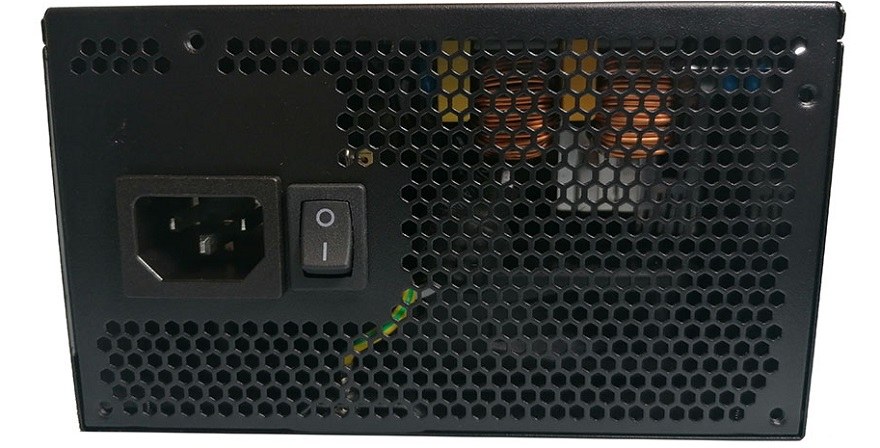
The only mild aspect of criticism we could give is that through the design, you can see into the power supply and, by proxy, a lot of largely unfavourable colors are on display. It would’ve been nicer if Cooler Master had tidied this area up a little, but given that it’s at the rear, it’s not as if you’re going to be starting at it all day long either.

The sides of the power supply largely incorporate the product name and Cooler Master branding which is well located and genuinely adds to the overall aesthetic.

One of the side panels does contain all of the technical information surrounding the power supply which is a nice touch as this is unusually placed on the top or bottom. In other words, in a much more notable location and, in terms of visuals, it really doesn’t add anything positive.
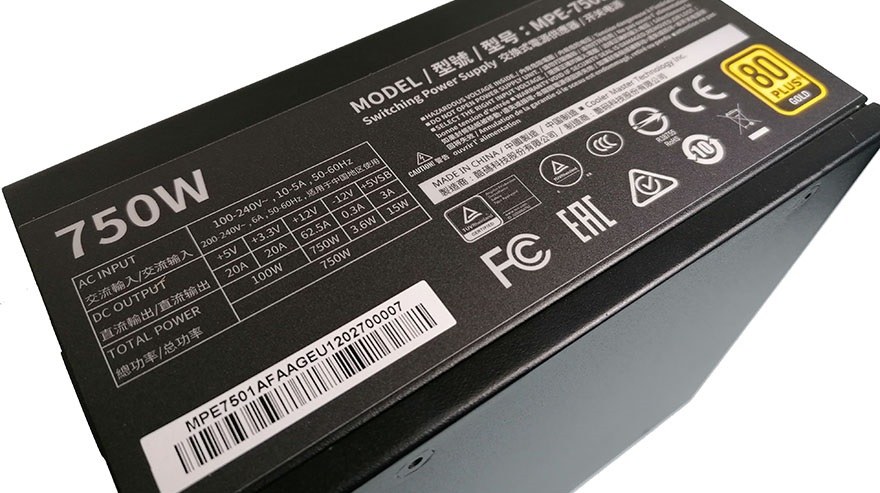
Coming with a sleek and solid aesthetic style, the Cooler Master MWE Gold 750 V2 certainly presents itself well. Albeit, as we noted above, there isn’t anything notably usual here that particularly makes it stand out from the majority of alternatives. Having a look inside, therefore, and of course at the other remaining aspects, seems a more than prudent move.

Cabling
Coming in a thick black plastic sheaving, the cables you are provided with are of an excellent length and, as such, should offer some excellent management options within some of the largest or unforgiving cases. With each cable specifically itemized to denote its use as well, you know exactly what you need to hook up your system and, more importantly, which end goes where!

Internals – A Look Inside!
Open opening the Cooler Master MWE Gold 750 V2 up, the main presentation is decent with all cables and components seemingly well managed within.

The fan itself used in this power supply is a ‘Ong Hua’ design which although not specifically manufactured by Cooler Master, is a design we see used within many power supply designs and, overall, while offering nothing particularly special, we’ve always found it to be a solid component in the past.
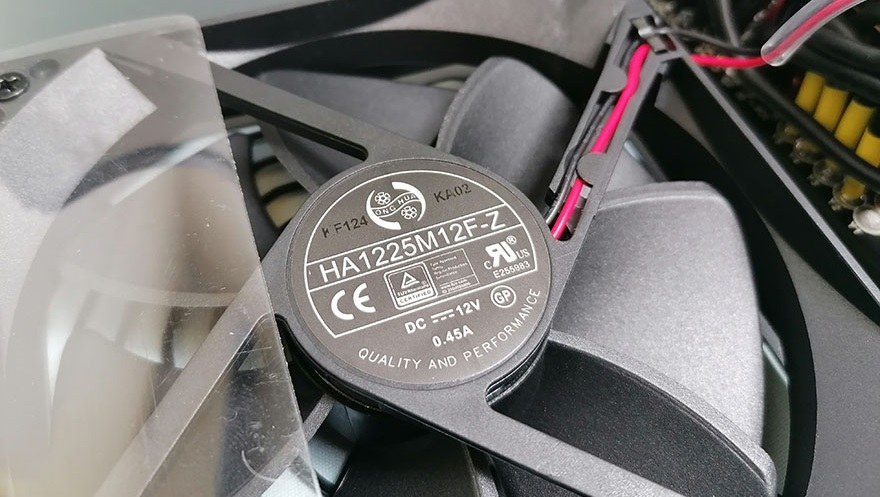
A closer look at the PCB gives us a bit of a mixed bag of impressions. While all of the components seem well situation and spaced, there’s rather a lot of unattractive colors on display here. Admittedly, you don’t largely see these when the power supply is fully assembled, but it does generally highlight that when the option was given to ‘tidy’ this up a bit, Cooler Master did not take it.
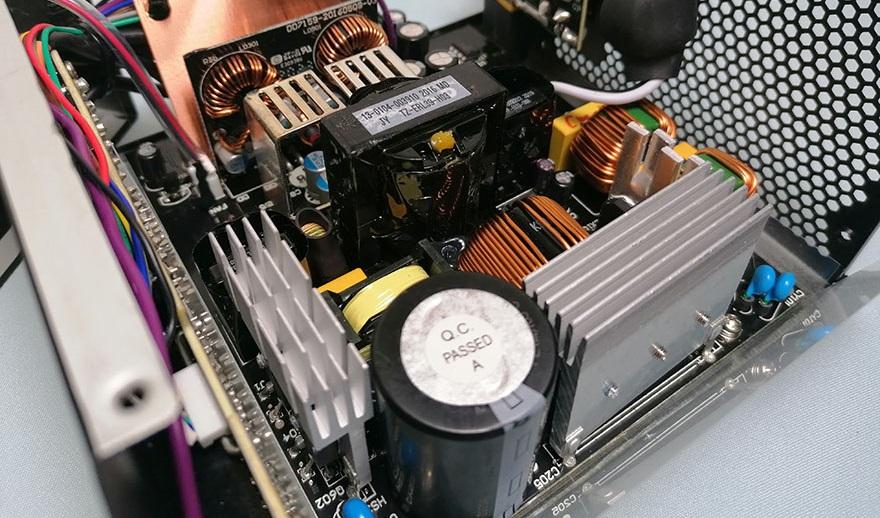
Unfortunately, due to the position its located within, we were unable to determine the make and, by proxy, origin of this power supplies main capacitor. All we can say for certain is that, for good or bad, it’s not a manufacturer we have encountered before.
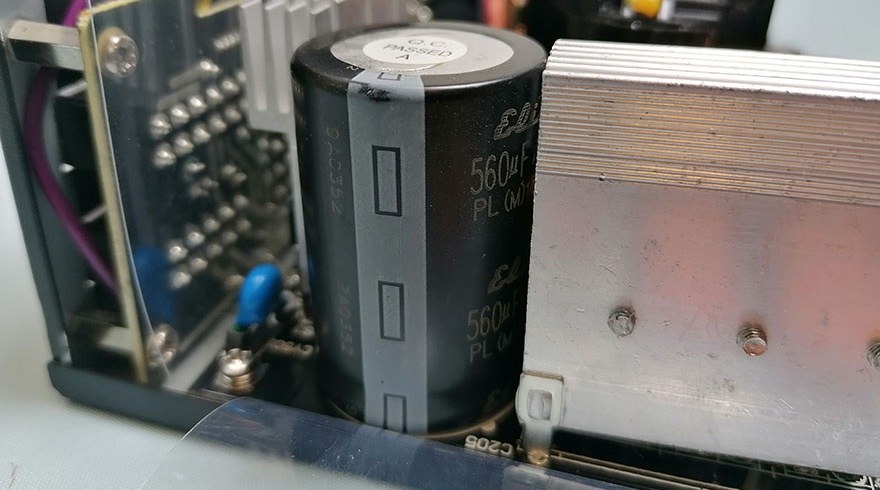
Overall Thoughts!
While there are certainly a number of factors that are unclear in regards to the Cooler Master MWE Gold 750 V2, there is nothing within or out that suggests that this is a badly designed power supply. In fact, on the contrary it looks like a solid proposition, but there is, of course, only one way to find out. Let’s get this strapped onto our testing machine!

Methodology & Testing
At eTeknix we take the power supply testing procedure very seriously and have invested a lot of resources into acquiring the appropriate testing equipment. For all power supply reviews, we test the power supplies with dedicated power supply testing equipment. This means we are able to get the most accurate results from our testing as opposed to using software benchmarks (such as OCCT) or multi-meter readouts which are broadly inaccurate.
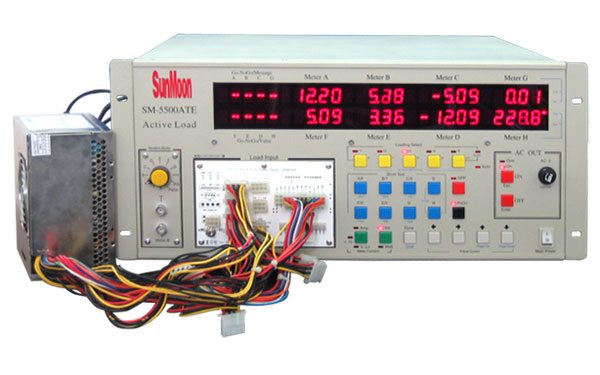
Testing Hardware
- Sunmoon SM-5500ATE Active Load Tester (1200W rated)
- Stingray DS1M12 USB Oscilloscope
- Voltcraft DT-10L laser tachometer
What the eTeknix Test Procedure Involves
- Testing each power supply at 20/40/60/80/100% load (with load balanced across all rails) and measuring PFC (power factor correction), efficiency (actual power divided by power “pulled at the wall”) and voltage regulation (deviance from expected voltages of 3.3/5/12 on the main rails).
- Measuring ripple with an oscilloscope at 20/40/60/80/100% load.
- Measuring fan speed after a stabilisation period of five minutes at each load scenario using the Voltcraft DT-10L laser tachometer and a reflective strip on the fan.
- Testing each power supply’s OPP (Over Power Protection) mechanism and seeing how many watts each power supply can deliver before shutting down
Other Things to Consider
- We recognise that a single 12-volt cable can provide only 6 Amps before overheating (which corrupts voltage regulation and efficiency) and so we used an adequate number of cables for each power supply to ensure there is not efficiency loss from poor cables selection
- Our Sunmoon SM-5500ATE power supply tester is not capable of testing more than 300W on each of the 12-volt rails so where a power supply provides more than 300W on a 12-volt rail that power is distributed over multiple 12-volt rails on the load tester. For example a power supply with one 12 volt rail supplying 750 watts would be spread equally over three 12 volt rails on the load tester, a power supply with two 450W 12v rails would be spread over four 12v rails on the load tester, two 225W 12v rails for each of the 12v rails on the unit.
- We use the same time scale and horizontal millivolt scale on our oscilloscope for all ripple tests, that is a 20ms T/DIV (horizontal) and a 0.02 V/DIV (vertical) meaning the scale is from -80mV to +80mV, ATX spec dictates that the 12v rail must fall within 150mv of ripple and the 3.3/5 within 50mv so that scale allows us to include both 150 and 50mV peaks. (Some older PSU reviews use different scales which were later ditched as the visual representation they give is inadequate, in these reviews written measurements are provided only).
- Deviance is the terminology used to represent the way voltages diverge from the expected values
Voltage Regulation
To test voltage regulation we load the power supply to five different load scenarios that give an equal spread of load across every single rail. So that means 20% on all rails, 40% on all rails and so on. We then calculate the average deviance of each rail from its expected voltage. Ideally, anything of +/- 2% regulation is seen as a very good result.
Power Efficiency
Power efficiency is measured by calculating actual supplied wattage divided by the wattage drawn at the wall/plug, multiplied by 100 to give a percentage. We then compare that to the particular 80 Plus certification the company claims to see if it meets that. You can see the 80 Plus certifications below, we always test power supplies at 230v.
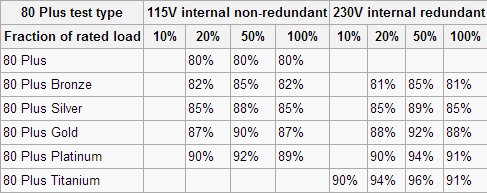
Power Factor Correction
Power Factor Correction is the ratio of the real power flowing to the load, to the apparent power in the circuit. The aim of PFC is to make the load circuitry that is power factor corrected appear purely resistive (apparent power equal to real power). In this case, the voltage and current are in phase and the reactive power consumption is zero. The closer the number to one the better as this allows the most efficient delivery of electrical power (Source – Wikipedia).
Ripple
Noise and Ripple can easily be measured by an oscilloscope. These show how much voltage fluctuation there is on a particular rail. We tested the rail stability of the 3.3-volt, 5-volt and 12-volt rails using an identical time and millivolt scale for all graphs. millivolt ripple is measured by the peak to peak size of the voltage curve.
The latest ATX 12 volt version 2.3 specifications state that ripple from peak to peak must be no higher than 50 millivolts for the 3.3-volt and 5-volt rails, while the 12-volt rail is allowed up to 120 millivolts peak to peak to stay within specifications. Millivolt figures are stated to the closest increment of 5 given their variability.
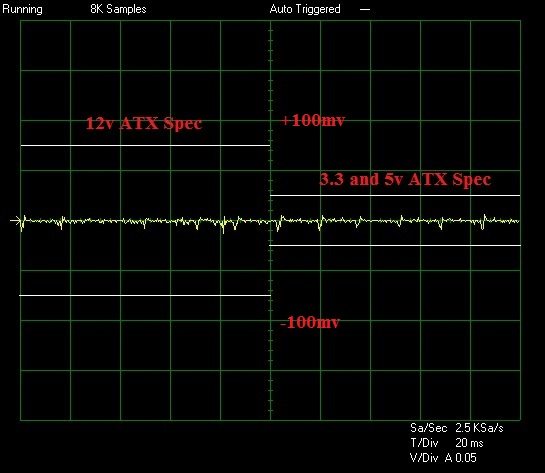
OPP
Power supplies often quote as having various protection mechanisms such and the most important of these is Over Power Protection. In our testing we crank up the power draw until the power supply either shuts down (meaning the OPP mechanism is present and working) or blows up (meaning it is either not present or not working). We then note the maximum power consumption before the power supply shut down, or before it blew up.
Fan Speed
When testing in a power supply laboratory it is difficult to take fan noise readings as the noise from the Sunmoon test equipment and air conditioning corrupts everything. The next best thing in our circumstances was reading off the fan speed with a tachometer to get an idea for the noise. The ambient temperature during testing held constant at 22 degrees, with 1 degree of variation. Each power supply had a consistent time period of 5 minutes to stabilise between each load scenario.
In my experience, the following general relationships apply between noise levels and fan speeds, though it can vary greatly between the type of fan used.
- Below 800 RPM – Inaudible/Silent
- 800 to 1000 RPM – Barely audible
- 1000 – 1200 RPM – Audible but still quiet
- 1200 – 1400 RPM – Moderately noisy
- 1400 – 1800 RPM – Noisy
- 1800 RPM or above – Intolerable
Efficiency
Given that the Cooler Master MWE GOLD 750 V2 is Gold efficiency rated, it is important to not only check that this is accurate, but also to determine just how well it fills that remit. So, how did it do? Well achieving an average of over 90%, this comfortably sits within the gold rating and is actually towards the top-end of that specification.
As such, in terms of our testing, we’re already off to a strong start here!
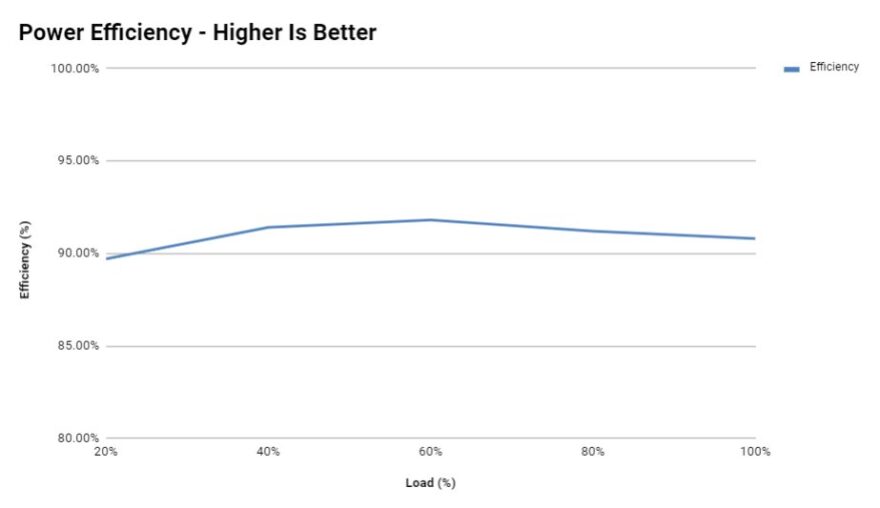
PFC (Power Factor Correction)
Although the PFC initially starts off quite low, this is both perfectly common and usual when power supplies are at 20% output levels. Generally speaking, they’re nearly always happier when asked to work harder. Once you start ramping up the demands, therefore, the PFC quickly rises to above 0.9 and then 0.95 which is exactly what is both good and exactly what you want to see.

Voltage Regulation
Although there are some moderate levels of deviancy noted in the Cooler Master MWE GOLD 750 V2, the main factor is consistency and, as you can see in the chart below, the results provided throughout the differing levels of output were generally speaking exactly the same. In fact, the 5V rail was not only consistent, but it’s results were absolutely perfect.
So , overall, while offering nothing particularly remarkable (other than that 5V result) there’s certainly nothing here to warrant any concern!

Ripple
In terms of measuring how cleanly the energy is delivered, the ripple results are again entirely solid. A particular highlight can be seen in both the 3.3V and 5V rails as the highest result recorded in our testing was only 5.8. Admittedly, the 12V results are clearly a little more excitable, but in regards to regulations, they are still massively below the maximum of 50 (under EU standards).
| Load (%) | 3.3V Ripple | 5V Ripple | 12V Ripple |
| 20 | 3.4 | 3.4 | 14.4 |
| 40 | 4.6 | 4.6 | 18.4 |
| 60 | 4.8 | 4 | 20.4 |
| 80 | 5.4 | 4.4 | 20.4 |
| 100 | 5.8 | 5.8 | 22 |



Over Power Protection and Max Wattage
Although technically rated to 750 watts of power output, it is neither unusual nor uncommon for power supplies to offer a fairly significant ‘overhead’. While it is always advisable to base your power supply on the needs of your system’s components, if you do ever have to ask it to work a little harder, it’s nice to know that there is some wiggle room to work with.
In regards to the Cooler Master MWE GOLD 750 V2, it achieved nearly 250 watts over its rated amount before the OPP’s successfully kicked in. As such, not only do you have plenty of ‘margin for error’, but if you do ever push your power needs a little too far, the protections will step in perfectly to prevent any components from potentially being damaged.

Fan Speed
In regards to the fan speed, Cooler Master has been keen to point out that one of the revisions made in this new design is the implementation of an improved fan design. In terms of it’s operating, aside from when at minimal load, the fan seemed to run at a fairly consistent 775-800RPM and in terms of noise levels, was barely audible.
So, if you value a cool and quiet system, the Cooler Master MWE GOLD 750 V2 certainly ticks both of those boxes! Within a PC case, you’d barely hear this PSU running at all!

How Much Does it Cost?
Available to purchase now for a price in the region of £99.99, in comparative terms, while not representing an outright bargain, it is at the very least consistent and highly-comparable with the various other gold rated power supplies at this wattage output level.
Better still, with the Cooler Master MWE GOLD 750 V2 coming with a pretty substantial 5-year warranty, that should just be enough to tip the scales in favor of this PSU.
Performance
While there were definitely some key highlights seen in our testing, the main key word we take away is ‘consistency’. It didn’t necessarily perform fantastically well in any one individual test, but taking them all as a whole, the Cooler Master MWE GOLD 750 V2 did everything you would want it to without any fuss or drama.
Yes, that might sound a little mundane, but let’s look at it this way; Do you want your power supplies to be solid and reliable, or exciting? Because I know which one I would pick!
Practicality & Functionality
Offering 750 watts of power output and 80-plus Gold efficiency, the Cooler Master MWE GOLD 750 V2 would represent an absolutely ideal choice for the vast majority of gaming PCs. While it doesn’t offer anything particularly exciting in terms of aesthetics or functionality, it’s still an entirely practical design that is undoubtedly taken to a good level with its easy to access power ports and very generous cable length.
Put simply, outside of the realms of super-extreme PCs, there isn’t a system out there that this probably wouldn’t be suitable for!
Should I Buy One?
The Cooler Master MWE GOLD 750 V2 is likely going to have a problem on the market and it’s, unfortunately, nothing to do with any perceived negative aspects because, quite frankly, there aren’t any. It’s an entirely solid power supply that is priced very reasonably and, on the whole, should represent an excellent purchase for the vast majority of PC consumers. The only major issue we can see is that, when compared to its competition, it doesn’t do much to stand out from the pack and even the name itself is pretty boring.
If the Cooler Master MWE GOLD 750 V2 should ping on your radar, however, we only have good things to say about it and, throwing that 5-year warranty into the mix, you’d be hard pushed to find anything better for this money!




















